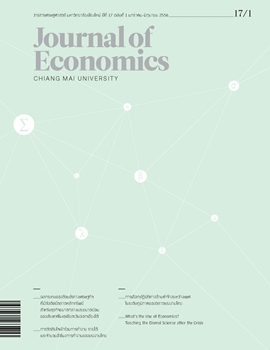การตัดสินใจเข้าร่วมการทำงาน รายได้ และจำนวนชั่วโมงการทำงานของแรงงานไทย
Keywords:
แรงงานไทย, การตัดสินใจเข้าร่วมการทำงาน, รายได้, ชั่วโมงการทำงาน, Thai Labor, Labor Force Participation, Income, Working HourAbstract
การวิจัยครั้งนี้มีวัตถุประสงค์คือ เพื่อศึกษาผลของโครงสร้างเศรษฐกิจและสังคมต่อระดับ รายได้ และจำนวนชั่วโมงการทำงานของแรงงานไทย โดยใช้ข้อมูลทุติยภูมิจากสำนักงานสถิติ แห่งชาติ ใน 4 ช่วงเวลา คือ ปี พ.ศ. 2548, 2549, 2550 และ 2553 ตัวอย่างรวมทั้งหมดเป็น เพศชาย 11,582 คน และ เพศหญิง 11,999 คน รวมทั้งสิ้น 23,581 คน โดยไม่รวมผู้ประกอบ ธุรกิจส่วนตัว เกษตรกร และผู้ที่ทำงานอิสระ วิเคราะห์ข้อมูลโดยใช้แบบจำลองของ Heckman แล้วทำการประมาณค่าด้วยวิธี Full Maximum Likelihood แบ่งการวิเคราะห์ออกเป็น 3 รูปแบบคือ (1) การวิเคราะห์โดยกลุ่มตัวอย่างทั้งหมด (2) การวิเคราะห์โดยใช้กลุ่มตัวอย่าง เพศชาย และ (3) การวิเคราะห์โดยใช้กลุ่มตัวอย่างเพศหญิง ผลการศึกษาโดยใช้กลุ่มตัวอย่าง ทั้งหมดพบว่าตัวแปรสถานภาพสมรส จำนวนเด็กเล็ก และระดับการศึกษาส่งผลให้แรงงาน มีระดับรายได้มากขึ้น นอกจากนั้น ประสบการณ์ทำงานศักยภาพยังส่งผลให้แรงงานมีระดับ รายได้มากขึ้นแต่การเพิ่มขึ้นจะมีสัดส่วนที่ลดลงตามประสบการณ์ศักยภาพที่เพิ่มขึ้น และ ในแบบจำลองชั่วโมงการทำงานพบว่า สถานภาพสมรส จำนวนเด็กเล็ก และรายได้ส่งผลให้ แรงงานมีจำนวนชั่วโมงการทำงานที่เพิ่มขึ้น แต่อายุและระดับการศึกษาส่งผลให้จำนวนชั่วโมง การทำงานของแรงงานลดลง เมื่อแยกวิเคราะห์ตามเพศพบว่าผลการศึกษามีความแตกต่างกัน โดยสถานภาพสมรสส่งผลให้มีระดับรายได้เพิ่มขึ้นในเพศชาย แต่ลดลงในเพศหญิง และ จำนวนเด็กเล็กที่อยู่ในการดูแลของกลุ่มตัวอย่างส่งผลให้ระดับรายได้เพศชายลดลง แต่เพศหญิงเพิ่มขึ้น นอกจากนั้นแบบจำลองชั่วโมงการทำงานพบว่าตัวแปรอายุส่งผลให้ชั่วโมง การทำงานเพิ่มขึ้นในเพศชาย แต่ลดลงในเพศหญิง และจำนวนเด็กเล็กส่งผลให้ชั่วโมงการ ทำงานเพิ่มขึ้นในเพศชาย แต่ลดลงในเพศหญิง
LABOR FORCE PARTICIPATION, INCOME, AND WORKING HOUR OF THAI LABORS
This research has an objective of studying the impacts of socioeconomic factors structure per income level and amount of working hours of laborers in Thailand. This is done by using secondary data from the National Statistical Office (NSO) during four periods including the years of B.E. 2548 (2007), B.E. 2549 (2008), B.E. 2550 (2009), and B.E. 2553 (2010). This research was conducted using 23,581 samples; 11,582 men and 11,999 of women, limited to full-time laborers and the unemployed. The data was analyzed with a method of Heckman’s Full Maximum Likelihood. Because of the result of various factors affect the difference between men and women, the results were therefore separately analyzed into three models; (1) full-sample model, (2) male-gender-only-sample model, and (3) female-gender-only-sample model. According to the study, it was found in all samples that such factors as a marital status, numbers of young children, and an educational level affect and lead to a higher income. Moreover, work experience and potential also lead to a higher income, but such an increase is reduced, proportionate to an increasing amount of work experience and potential. In a model simulating different numbers of working hours, it was found that a marital status, numbers of younger children, income, and expenses lead to an increasing number of working hours of laborers. However, age and educational level lead to a reduction in numbers of working hours of laborers. Once an analysis is done specifically only on male and female laborers, the result was found to be different. In case of men, marital status leads to an increase in income but vice versa for women. The numbers of young children in the care of samples affect the rate of income in a way that they cause men’s rate of income to decrease, but cause women’s rate of income to increase. Moreover In a model simulating different numbers of working hours, an increase in age of men lead to an increase in their working hours, but a decrease for women. In the same way, an increase in numbers of young children in their care lead to an increase in men’s working hours, but a decrease for women.
Downloads
Issue
Section
License
All opinions and contents in the CMJE are the responsibility of the author(s). Chiang Mai University Journal of Economics reserves the copyright for all published materials. Papers may not be reproduced in any form without the written permission from Chiang Mai University Journal of Economics.
ข้อคิดเห็นที่ปรากฏและแสดงในเนื้อหาบทความต่างๆในวารสารเศรษฐศาสตร์มหาวิทยาลัยเชียงใหม่ ถือเป็นความเห็นและความรับผิดชอบโดยตรงของผู้เขียนบทความนั้นๆ มิใช่เป็นความเห็นและความรับผิดชอบใดๆของวารสารเศรษฐศาสตร์ มหาวิทยาลัยเชียงใหม่
บทความ เนื้อหา และข้อมูล ฯลฯ ในวารสารเศรษฐศาสตร์มหาวิทยาลัยเชียงใหม่ ถือเป็นลิขสิทธิ์เฉพาะของคณะเศรษฐศาสตร์มหาวิทยาลัยเชียงใหม่ หากบุคคลหรือหน่วยงานใดต้องการนำทั้งหมดหรือส่วนหนึ่งส่วนใดไปเผยแพร่ต่อหรือเพื่อกระทำการใดๆ จะต้องได้รับอนุญาตเป็นลายลักษณ์อักษร จากวารสารเศรษฐศาสตร์ มหาวิทยาลัยเชียงใหม่






